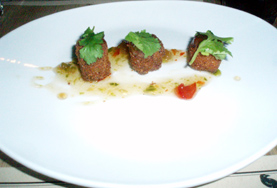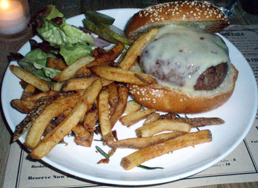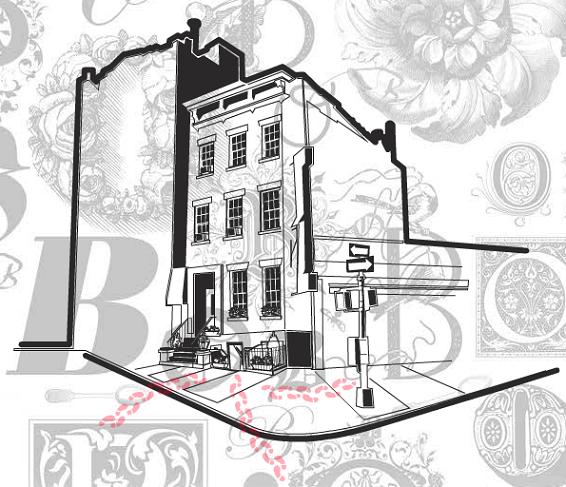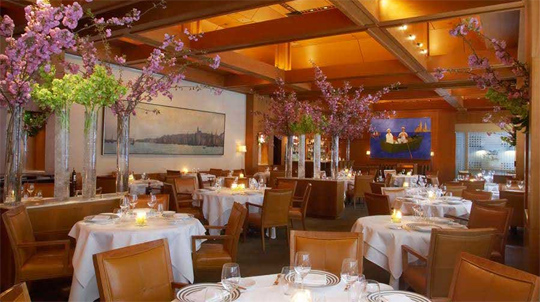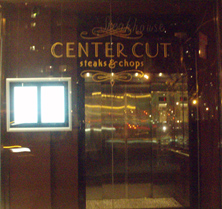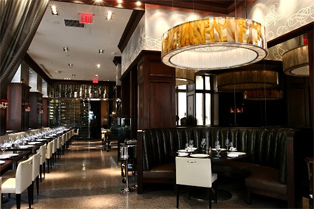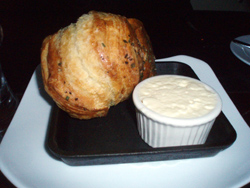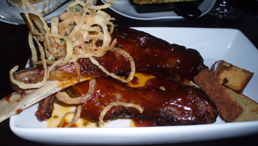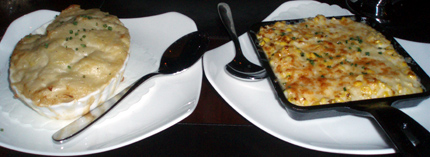
[Kreiger via Eater]
Note: Click here for a review of Corton on Valentine’s Day 2009, and here for a later visit in August 2009.
Dinner at the new restaurant Corton is like a double homecoming. It marks the return of chef Paul Liebrandt, last seen in New York during a brief, controversial tenure at Gilt. And it marks the return of the iconic space once the home of Montrachet, now almost unrecognizable after a stunning make-over.
Liebrandt has made waves wherever he cooked, but mainly he is known for acclaimed cuisine in restaurants that didn’t last very long. His last restaurant, Gilt, has survived—perhaps even thrived—but Liebrandt himself was forced out after disappointing reviews, including just two stars from Frank Bruni at a place clearly designed for three, or even four. I’m one of many who thought Bruni really missed the boat, but his reviews, not mine, are the ones that count.
Montrachet was the place that put chef David Bouley and restauranteur Drew Nieporent on the map in TriBeCa. Bouley left to start his own place, but Montrachet remained a successful three-star restaurant under a long line of chefs. The Times demoted it to two stars in 2004, and it finally closed in 2006 after an impressive 21-year run.
At Corton, which opened about a month ago, the foodies are once again rapturous over Paul Liebrandt’s cooking. He has toned down his act a bit. The three-course prix fixe at Liebrandt’s Gilt was $92, and many dishes carried high supplements. The wine list there included Screaming Eagle at $1,000 a glass. Gilt, indeed, was an appropriate name.
At Corton, the three-course prix fixe is $77, and the wine list is priced for a recession. No one would call Corton inexpensive, but it is priced like a restaurant that wants to earn its laurels, rather than one that presumes they are inevitable.
Since Montrachet, Drew Nieporent has opened one successful restaurant after another, including Tribeca Grill and the Nobu chain. The man knows how to open restaurants, and he is taking Corton very seriously. He was working the floor on a Saturday night, acting as maitre d’ and even busing tables. Originally, I was offered an 8:45 p.m. reservation, which was a bit later than I wanted. When Nieporent had a cancellation, he called me personally that evening to say we could come in early.
The cuisine at Corton is still recognizably Liebrandt’s—especially his love of beets—but it’s a far cry from the Gilt days. This is still luxury cuisine, but he’s not packing two dozen ingredients to the square inch, as he did before. If you’re familiar with his wilder self, it’s impossible to eat at Corton without hoping that the unrestrained Liebrandt will make a comeback. But if Corton is a success, there will be time for that later on.



You get a sense for the more laid-back Liebrandt with the amuses-bouches, which are simple and effective (above). The bread service came with two contrasting butters, but the baguettes weren’t as soft as I’d like.


For the starter, I ordered the Veal Sweetbreads (above left). You can’t see it in a photo, but there’s a poached egg under there too. After you puncture it, the egg yolk and the sweetbreads combine to pack a terrific flavor punch.
Foie Gras (above right) was wrapped in a hibiscus-beet gelée—a typical Liebrandt dish, perfectly executed.


Squab (above left) came wrapped in smoked bacon with a chestnut crème and a milk foam. This was a beautiful dish, though I can also imagine that a certain critic might complain about the hockey puck-sized fillets on the plate. The preparation was first-rate, but some might prefer to see visual evidence that this actually came from a bird.
The Filet of Black Angus Beef (above right) was the rare example of beef in a non-steakhouse restaurant that is actually worthwhile, even though the prepration seems comparatively simple. Yes, there are beets on that plate too, with an Oxtail confit.


Robert Truitt’s desserts are wonderful. I’m afraid I didn’t take note of the palate cleanser (above left). We had the ‘Crème Cake’ with amaretto, orange, and vanilla-tamarind (above right) and the cheese selection (below right), and the meal concluded with an impressive selection of petits-fours.



The legendary Montrachet wine list, sadly, was auctioned off a couple of years ago, and sommelier Elizabeth Harcourt had to start from scratch. Its current incarnation certainly can’t match the old one, but there are some impressive bargains here. Two full pages headed “French Country Wines” feature bottles between $30–60, including plenty, both white and red, below $45. That is practically unheard of these days, especially in a restaurant at this price range.
At $75 and under, you’ll have plenty of options. Indeed, though I told her I was willing to spend that much, she recommended a 2006 Lirac at just $50. That is the largest gap I can remember between my budget and a sommelier’s suggestion. It shows that Corton is serious about earning repeat business with a wine program that doesn’t break the bank.
The in-house wine list is only 15 pages, with an additional 25 pages’ worth on a “reserve list” that is kept offsite, and can only be ordered in advance. Almost all of those wines are priced above what I would spend, even on a special occasion, but keeping them offsite limits diners’ flexibility and eliminates the possibility of an impulse buy.
Service was polished and confident: you wouldn’t think this restaurant is just a month old. The early part of the meal was a bit rushed. We ordered champagne to begin, and we thought we were sending obvious cues that we didn’t want to order food instantly. The staff seemed, if anything, a bit nervous that we would feel offended if we were just left alone for a while.
The restaurant was about 80% full—not bad, but probably not where they want to be on a Saturday night. Liebrandt is a first-class talent, in in Drew Nieporent he has a partner who knows how to steer a restaurant through a recession. Let’s hope they get the recognition they deserve.
Corton (239 West Broadway between Walker & White Streets, TriBeCa)
Food: ***
Service: ***
Ambiance: ***
Overall: ***
 Friday, November 28, 2008 at 06:14PM
Friday, November 28, 2008 at 06:14PM 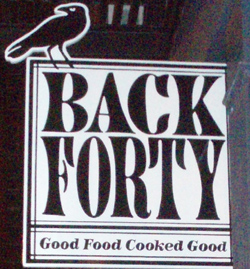 Sure enough, a year later came Back Forty, a more casual restaurant than Savoy, but in the same haute barnyard style that Hoffman made popular before everyone was doing it. Actually, the décor feels a bit like a gussied-up barnyard, with hefty wooden tables and farm implements hanging from the walls.
Sure enough, a year later came Back Forty, a more casual restaurant than Savoy, but in the same haute barnyard style that Hoffman made popular before everyone was doing it. Actually, the décor feels a bit like a gussied-up barnyard, with hefty wooden tables and farm implements hanging from the walls.